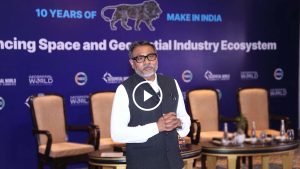Ankit Bhateja, Founder & Director of Bangalore-based, Xovian Aerospace that provides sustainable solutions in satellite technologies, shares his thoughts on the newly launched National Geospatial Policy 2022. He emphasizes on the challenges the policy addresses as well as the future opportunities and expectations from it.
What are your views on the National Geospatial Policy 2022?
National Geospatial Policy 2022 is one of the most refined policies out there that tries to take a 360 degree approach and talks about “What” to be done “How” to be done & “When” to be done in an articulated manner.
The policy not only talks about the enablement of the ecosystem but also emphasizes on the key growth pillars like Infrastructure, Standardization & future manpower creation that are hastily needed for sector like this.
These reforms will help to fuel the global aspirations of India’s geospatial industry and to Embark India’s transformative journey for an Atmanirbhar Geospatial sector of tomorrow, thereby enabling today’s startups to become tomorrow’s multinationals.
How forward looking the policy is?
Geospatial is one of those sectors that directly or indirectly impact multiple other sectors and its transformation can bring great impact across industries by bringing efficiency & transparency across value chains which can help to expedite India’s growth engine to quickly reach $5 trillion GDP mark with a sustainable approach.
On one hand this growth momentum relies on the creation of new infrastructure and enablement mechanisms for the future ready market, which are very well defined in a phased manner in the policy but on other hand the key to make India a geospatial power house & to capture a significant stake in this multi-billion-dollar global market lies in the manpower and skillset creation.
Establishment of incubators for the new innovation in this domain and enabling knowledge infrastructure will act as a catalyst in realizing the vision of the policy.
What are the new opportunities that this policy will unravel?
With the enablement of the ecosystem Policy will create a new playing field for the innovators and will help to create new job opportunities in the years to come.
What are the pain points that the policy has addressed?
Geospatial industry consumes a combination of datasets generated by aerial, terrestrial & space-based systems.
Current space based geospatial data distribution takes place via NRSC which collects and disseminates data products from ISRO’s satellites. Whereas, DST’s NATMO is also engaged in digital mapping through various technology means and has one of world’s largest spatial & non-spatial data repositories which is made available through its online platform. At the same time we also have Survey of India and Ministry of Earth Sciences making its data available through its own data dissemination portals.
Furthermore, geospatial industry also consumes multiple other datasets which are usually collected via terrestrial sensor networks.
For example:
1) SCADA based datasets for monitoring the natural resources via pipeline and other means: collected smart city authorities
2) IOT datasets: collected by the URBAN planning and agriculture authorities
3) Geodetic/CORS network datasets: collected by the survey of India
4) Maritime Situational awareness datasets: collected by the marine coastal towers
5) Ocean monitoring datasets collected by INCOIS, Oceans observation network of Ministry of Earth Sciences
6) Weather datasets from the ground stations and balloons: collected by the IMD
7) PPM/Environment pollution datasets: collected by the health & city planning departments etc.
This shows a lack of coordination between these multiple agencies and department leading to the formation of endless data portals with no single window access.
- There are no standard procedures defined for the procurement of these datasets.
- Unavailability of a single window information platform that can provide details about the overall data availability in the country. Although, NRSC and other ISRO departments conduct online workshops and webinars to provide the know how about ISROs datasets on BHUVAN & BHOONIDHI but similar approach is missing from other agencies.
- Lack of standardization of datasets leads to a flow of substandard datasets that ultimately impacts the overall potential of the industry.
What are the future expectations from the policy?
1. Ease of Accessibility: Creation of a single window end-to-end portal irrespective of the department and means of data collection, consisting: product offerings, selection of products and built in online payment method based on the type of data access technique (historic access/api access/per image basis/area selection basis etc).
2. Knowledge portal on types of datasets and its specifications
3. Clarity on the purchase procedures, clearances, compliances
4. Coordination between the departments that overlook the industries associated with the Geospatial sector: DOS| MOES | DST | DGCA | SOI & other associated departments.
5. Introduction of bridging Guidelines in the existing or upcoming policies that are directly or indirectly related to the geospatial sector.
Example: Any Claus in Geospatial Policy, Drone Policy or upcoming space policy that directly or indirectly talks about the specification of geospatial data or talks about its specifications or standardization, must convene the same meaning across policies. Including its resolution/accuracy/sensor specific definitions etc. This can be mentioned under a separate section containing identical Claus.









